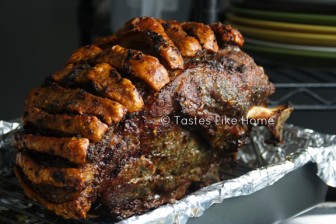Hi Everyone,
Cooking for the holidays can be a royal pain. While I can’t give you a leg up, I can certainly give you a shoulder. A shoulder to roast, low and slow, freeing you up to relax. Actually, if you put it in the oven before going to bed at night, it will be ready by the time you wake up, finish having a leisurely breakfast and reading the papers. Now, doesn’t that sound like perfection?
Let me ask you a few other questions.
Do you want meat so tender that it falls off the bone?
Do you want succulent meat?
 Do you want to cook your holiday roast and not be constantly basting or checking for temperature and doneness?
Do you want to cook your holiday roast and not be constantly basting or checking for temperature and doneness?
Do you want to have crackling that there’s bound to be a fight over? (That’s a good thing, the fighting part)
Do you want to save some money?
If you answered yes to all the questions, then read on.
Let’s start with the last question first. Forget the leg this year – the leg of pork or the leg of lamb, opt instead for the less expensive cut – the whole pork shoulder or the whole lamb shoulder. Here’s why, the shoulder cuts have the right amount of meat to bone to fat ratio. This cut of meat benefits gloriously from low and slow cooking by breaking down muscle to yield tender meat, melting fat to naturally baste the meat and keeping it moist because the roast is bone-in.

Roasting low and slow also means never having to worry if the roast is done, it is that forgiving. This low and slow cooking is going a step beyond well done. All you have to do is calculate the time based on the weight of the meat. Make a note of the time the roast goes into the oven and the time it should come out of the oven. It is almost fool proof. So this year when you are ordering your meat, or as the Bajans would say, when you are engaging the meat, tell your butcher that you want the whole shoulder instead of the leg. If pork is not your thing, lamb or mutton works too.
I’ve explained to you before which part of the animal the shoulder cut is but just to refresh your memory, as you may need to explain to your butcher. The shoulders are the front “legs” of the animal. These get worked more. There’s more muscle to breakdown, hence the great benefit from low and slow cooking. It is also more flavourful. The back legs are generally larger and meatier, leaner, and thus can dry out quickly if careful attention is not paid to the cooking time and internal temperature of the meat while cooking. While crackling – the skin cooked to crispness – may not be an issue for you, it is a major one for me and all pork-loving people. The shoulder allows for the long cooking that results in the skin going from rubbery to crisp crackling that that snaps and crunches. With the roasting of the leg, crackling can be tricky as cooking the meat longer just so the skin can become crisp can cause the meat to dry out. In some cases, you would have to remove the skin when the meat is done and return it (skin) to the oven just so that it can crisp up. Sorry, that’s too much work for me.
So what do you say? Want to give the shoulder roast a try this year?
Slow Roast Pork Shoulder
INGREDIENTS
1 whole pork shoulder
Salt and pepper to taste
Herb paste (recipe follows)
Herb paste:
¾ cup chopped onions
8 large cloves garlic, crushed
3 tablespoons fresh thyme leaves
5 fresh bay leaves, stems removed and leaves chopped
Chopped hot pepper to taste
Salt
3 tablespoons oil
DIRECTIONS
For herb paste:
Add all of the ingredients – except the oil – to a mortar with pestle or any tool/equipment you use to grind things to a paste or puree. Be generous with the salt as this will be used to season the entire roast.
Once the aromatics are ground to a paste, add the oil and blend or mix well. Set aside the paste.
For roast:
Rinse and pat dry the roast with paper towels.
Score the skin using a sharp paring knife. Cut through the skin and fat but try not to cut the meat itself.
Turn the meat skin side down and use your paring knife to make deep stabs/incisions in the meat; be sure to do the sides too.
Mix the salt and pepper together and sprinkle into the cuts of the meat.
Rub the paste all over the meat, massaging it in. Get in between the scored skin and fat too. Use your hands; they are the best tools to get the job done. Transfer the meat to a large 2-gallon plastic bag or wrap tight with lots of plastic wrap. Place onto a tray and refrigerate overnight. You can refrigerate for longer but no more than 24 hours. If you don’t have the time, let the meat marinate at room temperature for 2 hours.
If refrigerated, bring the meat to room temperature before roasting.
Preheat oven to 300 degrees F.
Line a roasting pan with foil (optional for easy clean up) and insert a metal rack into pan or if using a sheet pan, place a wire rack over the pan. If you don’t have a metal/wire rack, not to worry. Use the pan alone.
Unwrap meat, transfer to baking pan, skin side up, and roast until meat is cooked through – average 1 hour to 1 pound of meat. I did a 10-pound roast so I roasted my pork shoulder for 10 hours, low and slow.
When the time is up, raise the heat to 500 degrees F and roast for an additional ½ hour to crisp up the skin. Check after the first 15 minutes to ensure that it does not burn; the skin will get very brown (that’s okay, but try not to let it turn black). Let roast for the additional 15 minutes or until the skin is hard and sounds shallow when rapped.
Remove pan with meat from oven and let cool for at least 1 hour before serving. Remove the crackling (the crisp skin) and cut up the meat for serving. The meat will be so tender that you won’t have to do any fancy carving, just take off hunks of meat. Divide up the crackling for serving.
NOTES
If roasting lamb or mutton shoulder, average 35 minutes per pound for the lamb and 45 minutes per pound for mutton.
If you want to roast the leg of the pork, average 25 minutes per pound.




